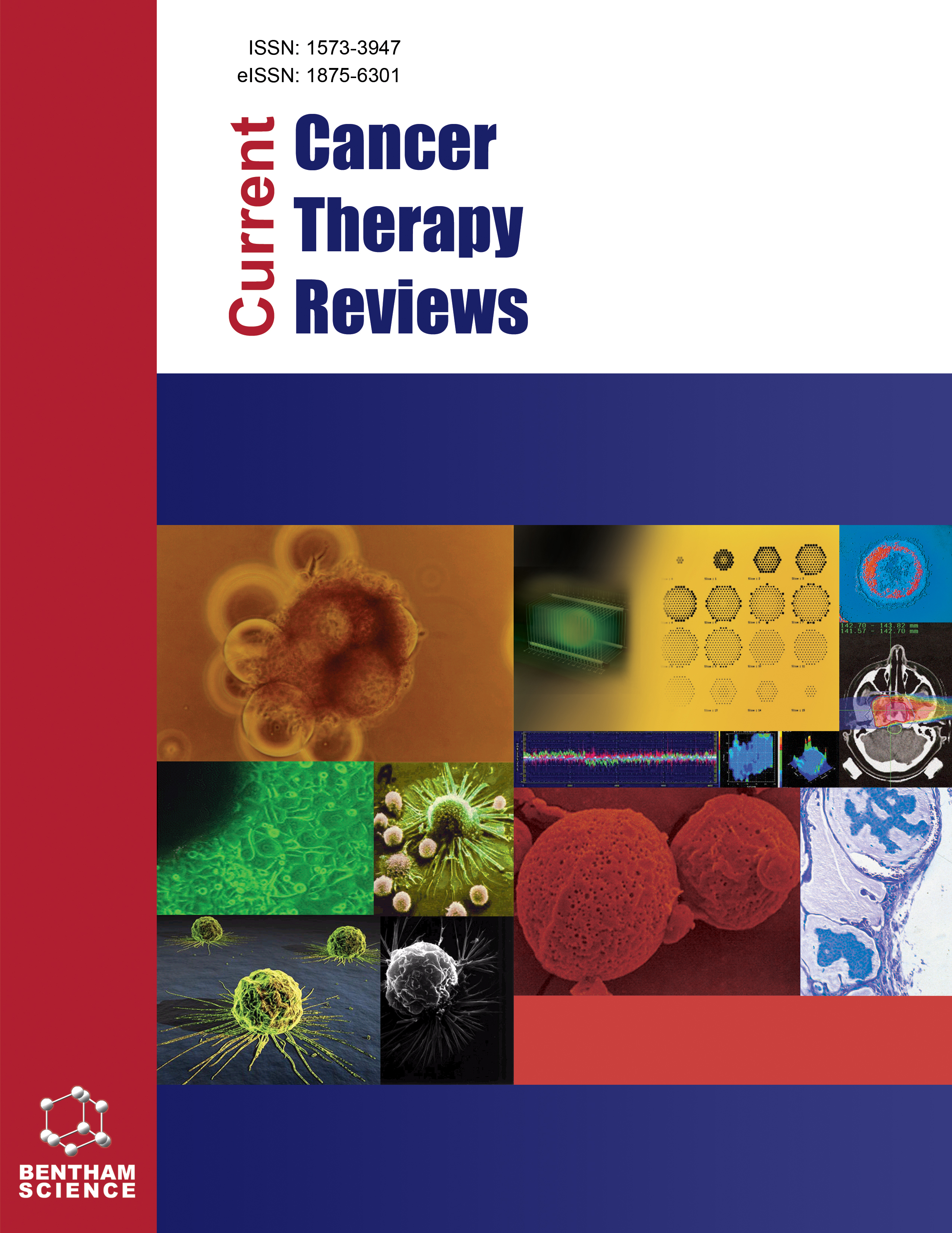- Home
- A-Z Publications
- Current Cancer Therapy Reviews
- Previous Issues
- Volume 8, Issue 1, 2012
Current Cancer Therapy Reviews - Volume 8, Issue 1, 2012
Volume 8, Issue 1, 2012
-
-
Editorial from EIC
More LessCurrent Cancer Therapy Reviews is now in its 8th year and relatively well known (not least for the brilliant collage at the front cover). According to the Cancer Statistics, 2011, published in the American Cancer Society's journal: “CA: A Cancer Journal for Clinicians”, a total of 1,596,670 new cancer cases and 571,950 deaths from cancer are projected to occurr in the U.S. in 2011. These numbers rise some skepticism regardin Read More
-
-
-
Editorial [Hot Topic: The Current World Health Organization Classification of the Myeloproliferative and Myelodysplastic/myeloproliferative Neoplasms and Correlation with Pertinent Targeted Therapy (Guest Editor: Cherie H. Dunphy)]
More LessThe 2008 WHO classification system for hematological malignancies is comprehensive and requires the integration of histopathologic/cytomorphological, immunophenotypic, cytogenetic, and molecular data. Myeloid neoplasms include acute myeloid leukemia, myelodysplastic syndromes (MDSs), myeloproliferative neoplasms (MPNs), MDS/MPNs, and myeloid and/or lymphoid malignancies associ Read More
-
-
-
Chronic Myelogenous Leukemia
More LessChronic myelogenous leukemia, BCR-ABL1+ (CML) is a myeloproliferative neoplasm characterized by a BCRABL fusion gene and almost always exhibits the characteristic cytogenetic finding t(9;22)(q34;q11). The protein product of BCR-ABL1 is a constitutively active tyrosine kinase whose function is intrinsic to CML pathogenesis. Patients present with leukocytosis and often splenomegaly and prominent marrow hypercellula Read More
-
-
-
Myeloproliferative Neoplasms Including Polycythemia Vera, Essential Thrombocythemia, and Primary Myelofibrosis, Chronic Neutrophilic Leukemia, and Myeloproliferative Neoplasm, Unclassifiable
More LessMyeloproliferative neoplasms (MPNs) are clonal bone marrow (BM) proliferations that most often manifest as increased peripheral blood (PB) counts and/or splenomegaly. Unlike myelodysplastic syndromes, the hemopoiesis in MPN is effective, leading to the increased peripheral counts; unlike the acute leukemias, there is intact maturation of all hematopoietic lineages. The main MPN entities discussed in this chapter are Read More
-
-
-
Chronic Eosinophilic Leukemia, Not Otherwise Specified (CEL, NOS)
More LessChronic eosinophilic leukemia, NOS (CEL, NOS) is considered a myeloproliferative neoplasm and is defined as a clonal proliferation of eosinophil precursors. This review presents the definition and characteristic cytomorphological, immunophenotypic, cytogenetic, and molecular features of CEL, NOS and discusses in depth the differential diagnoses. Following this presentation, the review then focuses on therapeutic approach Read More
-
-
-
Mastocytosis
More LessMastocytosis or mast cell disease represents a clonal, neoplastic proliferation of mast cells that can present in one or multiple organs, varying from indolent to aggressive disorders in adult and pediatric patients. This review presents the definition of the various forms of mastocytosis along with the characteristic cytomorphological, immunophenotypic, cytogenetic, and molecular features and discusses in depth the differential dia Read More
-
-
-
Myeloid and Lymphoid Neoplasms with Eosinophilia and Abnormalities of PDGFRA, PDGFRB or FGFR1
More LessMyeloid and lymphoid neoplasms with eosinophilia and abnormalities of PDGFRA, PDGFRB, or FGFR1 result from formation of a fusion gene encoding an aberrant tyrosine kinase. The cell of origin in those neoplasms associated with abnormalities of PDGFRA or FGFR1 is a mutated pluripotent (i.e., myeloid-lymphoid) stem cell, and thus the development of myeloid and lymphoid neoplasms associated with these abno Read More
-
-
-
Myelodysplastic/Myeloproliferative Neoplasms
More LessThe myelodysplastic/myeloproliferative neoplasms represent disorders, which at initial presentation, demonstrate overlapping features of myelodysplasia and myeloproliferation. Entities included in this group of neoplasms are chronic myelomonocytic leukemia, atypical chronic myeloid leukemia, juvenile myelomonocytic leukemia, and myelodysplastic/ myeloproliferative neoplasm, unclassifiable (including refractory ane Read More
-
-
-
Personalized Diabetes and Cancer Medicine: A Rationale for Anti-Diabetic Nutrition (Bitter Melon) in a Supportive Setting
More LessAuthors: Zanker K.S., Mang B., Wolters M and Hahn A.Recent discoveries in epidemiology and molecular epidemiology suggest a link between cancer risk, cancer progression and diabetes risk factors and treatment. Obesity, physical inactivity, smoking, mal nutrition and age are common risk nominators for both diseases. Furthermore due to these risk factors, tumor patients are often comorbid with diabetes type 2. Therefore, it is an urgent need in order to meet at least one Read More
-
Volumes & issues
-
Volume 21 (2025)
-
Volume 20 (2024)
-
Volume 19 (2023)
-
Volume 18 (2022)
-
Volume 17 (2021)
-
Volume 16 (2020)
-
Volume 15 (2019)
-
Volume 14 (2018)
-
Volume 13 (2017)
-
Volume 12 (2016)
-
Volume 11 (2015)
-
Volume 10 (2014)
-
Volume 9 (2013)
-
Volume 8 (2012)
-
Volume 7 (2011)
-
Volume 6 (2010)
-
Volume 5 (2009)
-
Volume 4 (2008)
-
Volume 3 (2007)
-
Volume 2 (2006)
-
Volume 1 (2005)
Most Read This Month
Article
content/journals/cctr
Journal
10
5
false
en


